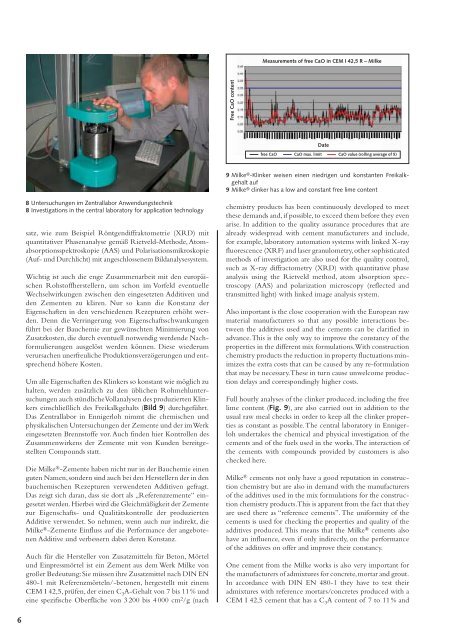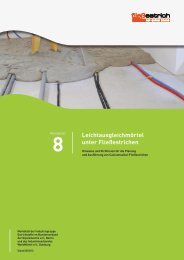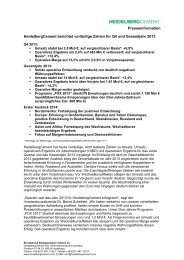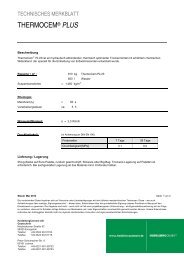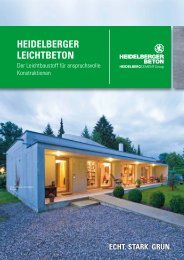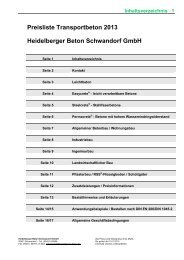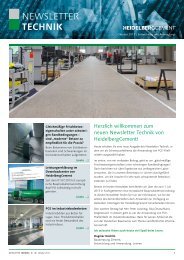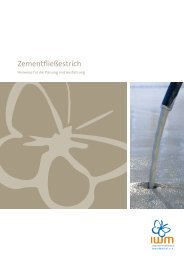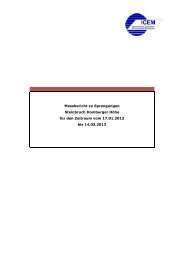Milke Zement: Entscheidend ist die ... - HeidelbergCement
Milke Zement: Entscheidend ist die ... - HeidelbergCement
Milke Zement: Entscheidend ist die ... - HeidelbergCement
Sie wollen auch ein ePaper? Erhöhen Sie die Reichweite Ihrer Titel.
YUMPU macht aus Druck-PDFs automatisch weboptimierte ePaper, die Google liebt.
6<br />
8 Untersuchungen im Zentrallabor Anwendungstechnik<br />
8 Investigations in the central laboratory for application technology<br />
satz, wie zum Beispiel Röntgendiffraktometrie (XRD) mit<br />
quantitativer Phasenanalyse gemäß Rietveld-Methode, Atomabsorptionsspektroskopie<br />
(AAS) und Polarisationsmikroskopie<br />
(Auf- und Durchlicht) mit angeschlossenem Bildanalysesystem.<br />
Wichtig <strong>ist</strong> auch <strong>die</strong> enge Zusammenarbeit mit den europäischen<br />
Rohstoffherstellern, um schon im Vorfeld eventuelle<br />
Wechselwirkungen zwischen den eingesetzten Additiven und<br />
den <strong>Zement</strong>en zu klären. Nur so kann <strong>die</strong> Konstanz der<br />
Eigenschaften in den verschiedenen Rezepturen erhöht werden.<br />
Denn <strong>die</strong> Verringerung von Eigenschaftsschwankungen<br />
führt bei der Bauchemie zur gewünschten Minimierung von<br />
Zusatzkosten, <strong>die</strong> durch eventuell notwendig werdende Nachformulierungen<br />
ausgelöst werden können. Diese wiederum<br />
verursachen unerfreuliche Produktionsverzögerungen und entsprechend<br />
höhere Kosten.<br />
Um alle Eigenschaften des Klinkers so konstant wie möglich zu<br />
halten, werden zusätzlich zu den üblichen Rohmehluntersuchungen<br />
auch stündliche Vollanalysen des produzierten Klinkers<br />
einschließlich des Freikalkgehalts (Bild 9) durchgeführt.<br />
Das Zentrallabor in Ennigerloh nimmt <strong>die</strong> chemischen und<br />
physikalischen Untersuchungen der <strong>Zement</strong>e und der im Werk<br />
eingesetzten Brennstoffe vor.Auch finden hier Kontrollen des<br />
Zusammenwirkens der <strong>Zement</strong>e mit von Kunden bereitgestellten<br />
Compounds statt.<br />
Die <strong>Milke</strong> ® -<strong>Zement</strong>e haben nicht nur in der Bauchemie einen<br />
guten Namen,sondern sind auch bei den Herstellern der in den<br />
bauchemischen Rezepturen verwendeten Additiven gefragt.<br />
Das zeigt sich daran, dass sie dort als „Referenzzemente“ eingesetzt<br />
werden.Hierbei wird <strong>die</strong> Gleichmäßigkeit der <strong>Zement</strong>e<br />
zur Eigenschafts- und Qualitätskontrolle der produzierten<br />
Additive verwendet. So nehmen, wenn auch nur indirekt, <strong>die</strong><br />
<strong>Milke</strong> ®-<strong>Zement</strong>e Einfluss auf <strong>die</strong> Performance der angebotenen<br />
Additive und verbessern dabei deren Konstanz.<br />
Auch für <strong>die</strong> Hersteller von Zusatzmitteln für Beton, Mörtel<br />
und Einpressmörtel <strong>ist</strong> ein <strong>Zement</strong> aus dem Werk <strong>Milke</strong> von<br />
großer Bedeutung:Sie müssen ihre Zusatzmittel nach DIN EN<br />
480-1 mit Referenzmörteln/-betonen, hergestellt mit einem<br />
CEM I 42,5, prüfen, der einen C 3 A-Gehalt von 7 bis 11 % und<br />
eine spezifische Oberfläche von 3 200 bis 4 000 cm 2 /g (nach<br />
Free CaO content<br />
Measurements of free CaO in CEM I 42,5 R – <strong>Milke</strong><br />
Date<br />
free CaO CaO max. limit CaO value (rolling average of 5)<br />
9 <strong>Milke</strong> ® -Klinker weisen einen niedrigen und konstanten Freikalkgehalt<br />
auf<br />
9 <strong>Milke</strong> ® clinker has a low and constant free lime content<br />
chem<strong>ist</strong>ry products has been continuously developed to meet<br />
these demands and,if possible,to exceed them before they even<br />
arise. In addition to the quality assurance procedures that are<br />
already widespread with cement manufacturers and include,<br />
for example, laboratory automation systems with linked X-ray<br />
fluorescence (XRF) and laser granulometry,other soph<strong>ist</strong>icated<br />
methods of investigation are also used for the quality control,<br />
such as X-ray diffractometry (XRD) with quantitative phase<br />
analysis using the Rietveld method, atom absorption spectroscopy<br />
(AAS) and polarization microscopy (reflected and<br />
transmitted light) with linked image analysis system.<br />
Also important is the close cooperation with the European raw<br />
material manufacturers so that any possible interactions between<br />
the additives used and the cements can be clarified in<br />
advance.This is the only way to improve the constancy of the<br />
properties in the different mix formulations.With construction<br />
chem<strong>ist</strong>ry products the reduction in property fluctuations minimizes<br />
the extra costs that can be caused by any re-formulation<br />
that may be necessary.These in turn cause unwelcome production<br />
delays and correspondingly higher costs.<br />
Full hourly analyses of the clinker produced, including the free<br />
lime content (Fig. 9), are also carried out in addition to the<br />
usual raw meal checks in order to keep all the clinker properties<br />
as constant as possible.The central laboratory in Ennigerloh<br />
undertakes the chemical and physical investigation of the<br />
cements and of the fuels used in the works.The interaction of<br />
the cements with compounds provided by customers is also<br />
checked here.<br />
<strong>Milke</strong> ® cements not only have a good reputation in construction<br />
chem<strong>ist</strong>ry but are also in demand with the manufacturers<br />
of the additives used in the mix formulations for the construction<br />
chem<strong>ist</strong>ry products.This is apparent from the fact that they<br />
are used there as “reference cements”. The uniformity of the<br />
cements is used for checking the properties and quality of the<br />
additives produced. This means that the <strong>Milke</strong> ® cements also<br />
have an influence, even if only indirectly, on the performance<br />
of the additives on offer and improve their constancy.<br />
One cement from the <strong>Milke</strong> works is also very important for<br />
the manufacturers of admixtures for concrete,mortar and grout.<br />
In accordance with DIN EN 480-1 they have to test their<br />
admixtures with reference mortars/concretes produced with a<br />
CEM I 42,5 cement that has a C 3A content of 7 to 11 % and


